I washed my white shoes to ride 100 miles in the rain - but it was worth it: a coast-to-coast adventure
Riding the full breadth of southern Scotland in two days is no easy task. CW magazine editor Simon Richardson prays for a tailwind on the new, 256-mile Kirkpatrick coast-to-coast route
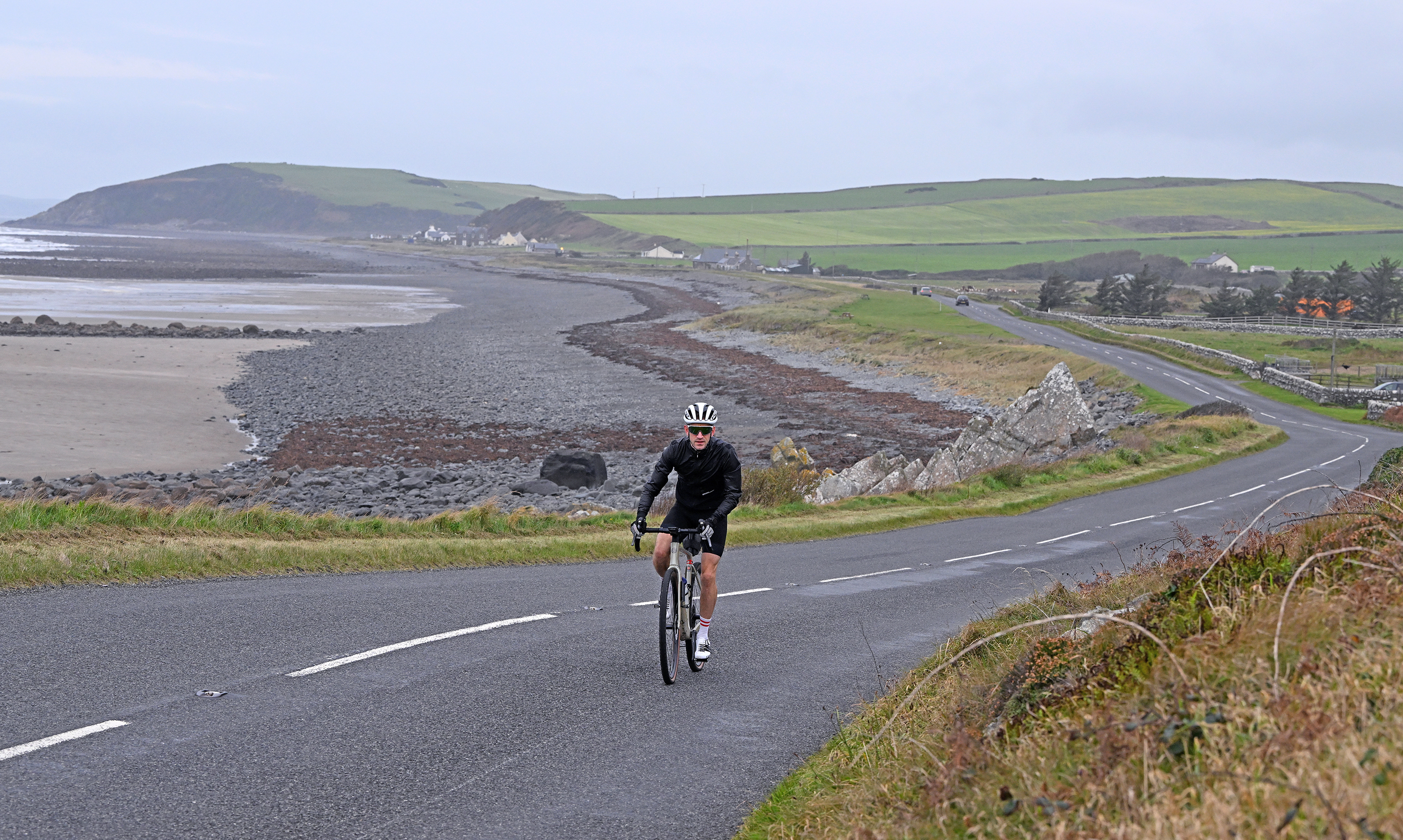

As I climb slowly out of bed my thoughts immediately turn to my shoes. Are they dry? The previous evening, the first thing I did after checking-in to our hotel in Langholm, tired, wet and dirty was get in the shower and thoroughly wash my once pristine white shoes. Covered in grime and soaked through, I got them sparkling clean before I turned the soap on myself. I’d smuggled some thick paper hand towels out of a cafe earlier in the day knowing I’d need to stuff them in my shoes overnight. I can’t start a ride with wet cycling shoes. I just can't. So in that cafe, even before I was halfway through day one, my thoughts had leapt forward to the start of day two.
The towels and heated towel rail had worked their magic. My shoes were clean and dry, and with fresh kit laid out, I instantly felt more positive about the 100 or so miles that lay ahead - despite my tired legs. A quick breakfast and we were soon getting the bike out of the back of the car. It was raining. Hard. In fact it had been raining most of the night, and water was streaming across the roads.
Two minutes later, on a quick circle of the town to navigate the one-way system, I’ve picked up the route on my Wahoo bike computer. I find myself riding past the front of our warm, dry hotel. Mile zero and my shoes and socks are drenched. Completely soaked through. Ah well, it was nice while it lasted. Let’s get going.
I’m in southern Scotland riding the new Kirkpatrick coast-to-coast route that officially opens this year. Named after Scottish Blacksmith Kirkpatrick Macmillan who is credited with inventing the first treadle bicycle, it’s a two-hundred-and-fifty-six-mile route from Stranraer in the west to Eyemouth on the east coast, along cycle routes, paths, quiet roads and through some stunning scenery.
It’s a part of the country steeped in a bloody history of battles between the English and the Scots, littered with castles and abbeys, and home to rugged coastline and rolling green hills. And despite the rain we’re encountering, it’s something of a haven for cycling.
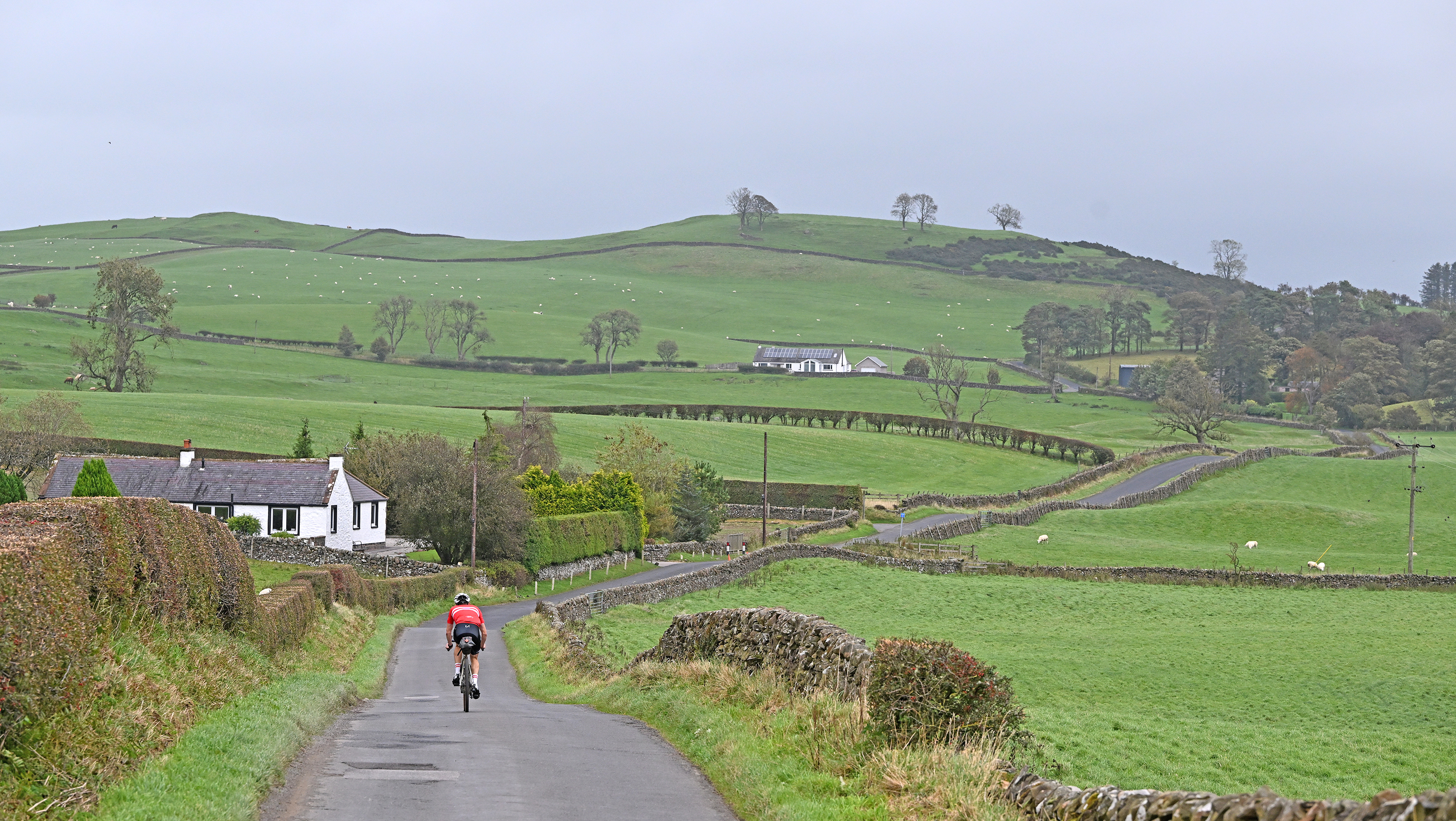
Kirkpatrick C2C ride day one, riding through farmland in Southern Scotland
“Are you going for the record?” a dog walker calls over as I pose for a photo on the beach at Stranraer. It’s overcast and feels like the heavy grey clouds are about to burst at any moment. “Not today,” I reply with false modesty. “Have you ridden it?”
“Parts of it,” he replies before going on to say his usual riding destination is in Dumfries and Galloway.
The latest race content, interviews, features, reviews and expert buying guides, direct to your inbox!
There’s not a bike rider to be seen; the route hasn’t been officially opened and there’s certainly no start banner or local dignitaries waving me off, so the fact this dog walker knows what I’m about to take on suggests the route is already fairly well trodden. Keen to get moving I clip clop up the concrete steps from the beach and set off. I ride down a residential street and straight onto the A75 main road, or at least on the shared cycle path next to it. Soon I turn right and into little lanes, turning left and right through farmland and past little lakes – or are they floodwaters? – without a town in sight.
At every turn there’s a sign. In fact, not just at the turn, but before and after each one. From Stranraer all the way to Dumfries, 102 miles of riding to the east, they do not miss a beat. Seamlessly navigating you along roads, paths, through woods and around or underneath busy junctions. This is thanks to Sustrans whose routes 73 and 7 combine to take you first from Stranraer to Newton Stewart and then on to Dumfries.
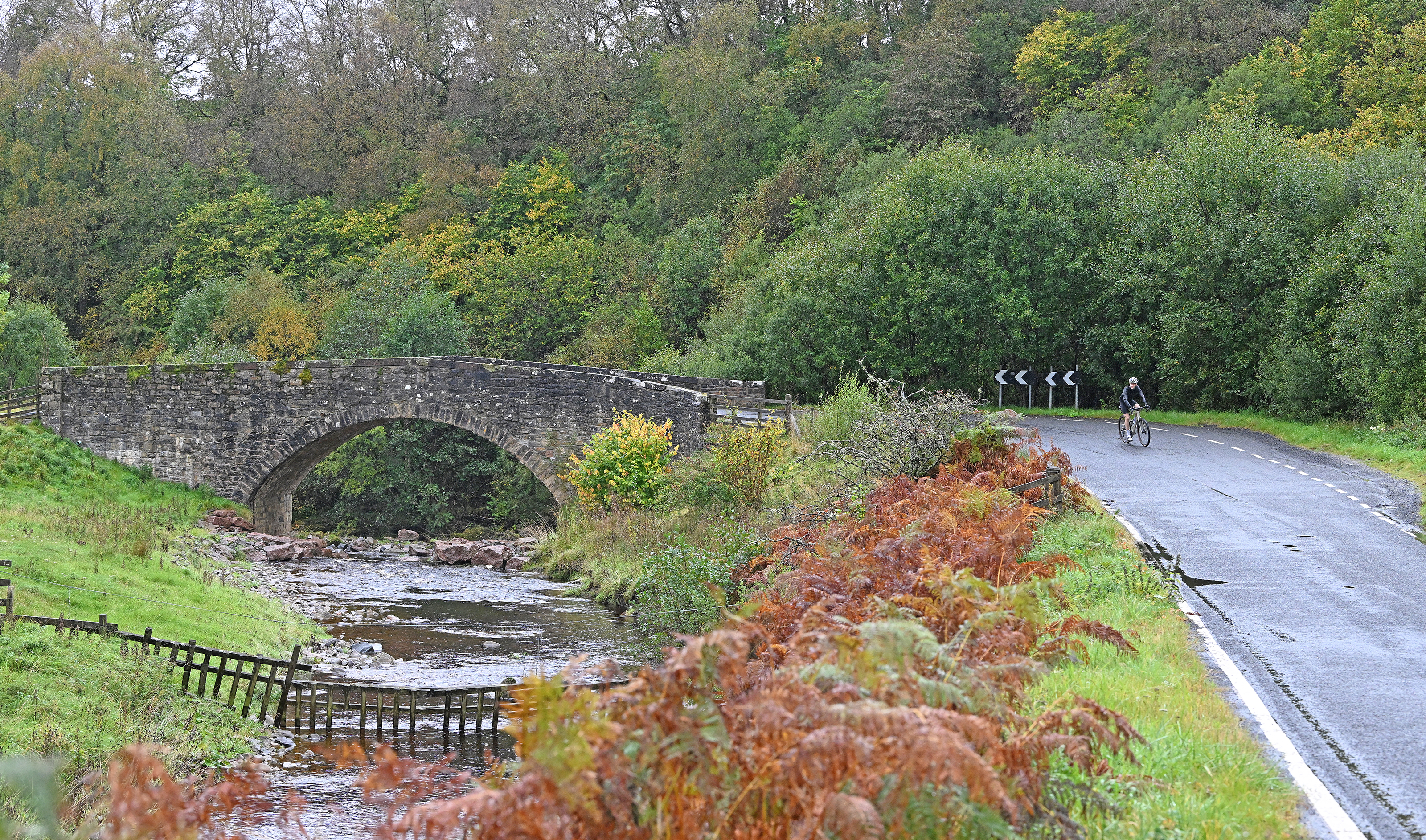
Kirkpatrick C2C ride day two, approaching the long climb out of Newcastleton
Most of these are small blue rectangles with a number in a red square and are easy to spot once you know what you’re looking for – and so numerous I could easily turn my Wahoo’s navigation off. There are plans for specific Kirkpatrick signs to be added this year, which will help over the second half of this route. From Dumfries on, I did need my head unit’s turn-by-turn navigation as signs were lacking in most places and some in-situ signs for other routes were pointing in a different direction.
Hitting the coast
Before too long I’m out on an exposed coastal road. The westerly wind is relentless, whipping in off the Irish Sea over my right shoulder. Thankfully it’s not a direct cross wind, but slightly behind, so helping my progress. Twenty miles into the ride and I turn left up the first proper climb, taking me away from the coast. This is where I’m hit by the full force of the wind, and much to my delight it is directly behind me.
The next 12 miles roll by in minutes as I cruise along at 50kph with little effort. Not only is the road flat and straight, but side roads are few and far between and traffic is non-existent. It’s not often that travelling at that speed on a bike is this easy, fun and safe. In fact, I’m not sure I’ve ever been so relaxed riding at that speed.
Kirkpatrick C2C route
A quick coffee stop in Wigtown where I fail in my attempt to dry out and we’re soon onto the biggest climb of the day out of Creetown. Again, with the wind behind, the five miles of gentle ascent is almost imperceptible. At the summit I can enjoy the views of the Big Water of Fleet Viaduct that cuts through the Cairnsmore of Fleet Nature Reserve.
The descent down to Gatehouse of Fleet is just as enjoyable as the views at the top, with sweeping bends, long straights and in general a good line of sight. At the bottom lies the Ship Inn, and as it’s lunchtime I decide it’s time to refuel.
The afternoon’s riding takes us along the picturesque road into Kirkcudbright, then inland to Castle Douglas and onto our destination of Dumfries. It’s these roads that typify the day’s riding: small, rolling country lanes, cutting through miles and miles of farmland and little else – no coffee stops this afternoon, sadly. I even get stopped by a farmer moving his cows from one field to another with the help of two quad-bike-riding herders.
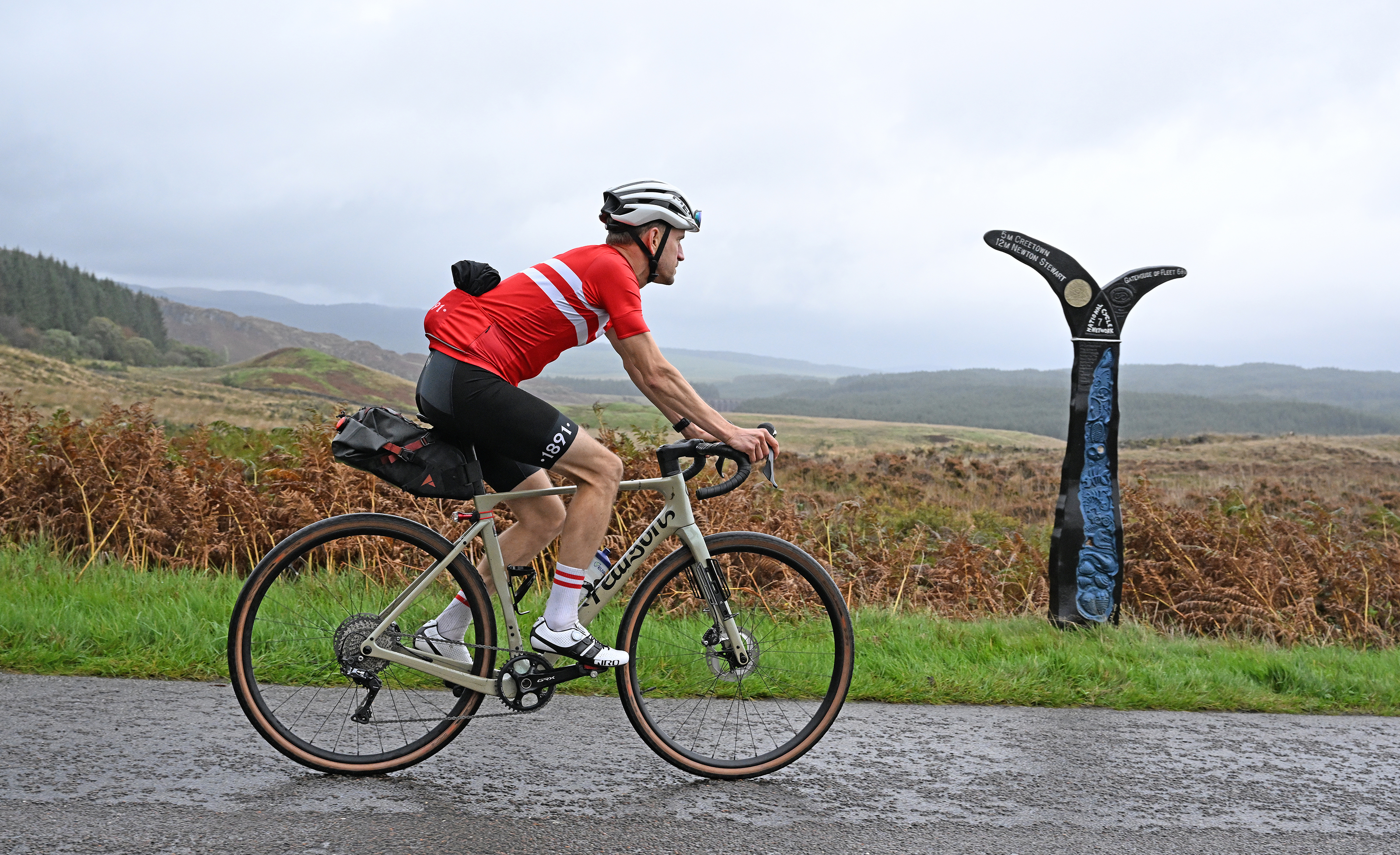
Kirkpatrick C2C ride day one, climb out of Creetown @Andy Jones
I take the enforced break as a chance to get the low-down on the breed we’re watching cross the road and what they’re good for. The farmer was clearly not impressed by my lack of bovine knowledge. Thankfully photographer Andy Jones knows his Hereford from this Belted Galloway.
The cycle lane takes me into the centre of Dumfries without a road in sight, and by now it’s getting dark. With over 80 miles in my legs, satisfied that I’ve done enough riding, I call it a day. We could have stayed here for the night, there are plenty of options, but our hosts have booked us into a hotel in Langholm, around 30 miles further along the route. I put on a dry top, jump in the car and we head off to find it.
It's all about the bike
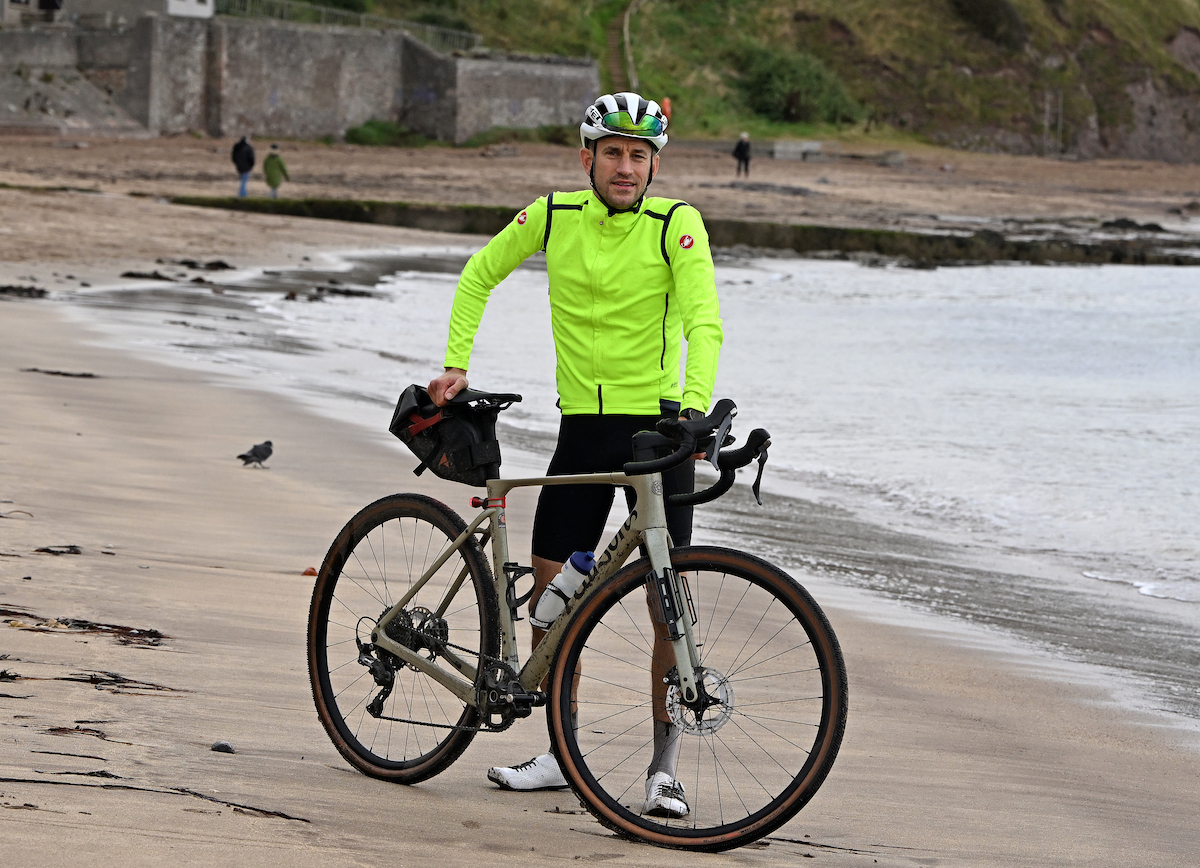
I rode a Pearson On and On gravel bike with X1 Shimano GRX 40 X 11-40 and Schwalbe G One 40mm file tread tyres. Chosen for its luggage carrying capacity I did in fact leave most of the baggage in the photographers car. We had a lot of ground to cover, and carrying bags at the front would slow me down, even with that tailwind.
With or without luggage it was a bike ideally suited for the ride. There were climbs and sections of road where a more slimline stretched out road bike would have been faster and allowed me to cover a bit more ground, but then it would have struggled on a few short sections. This isn’t a route setup for fast riding so the comfort and adaptability of a gravel bike was perfect. Even more so if carrying baggage.
The South of Scotland Destination Alliance that has overseen the creation of this route have brought us here, and done a top rate job of organising our accommodation. (Even delaying our stay when a bout of Covid prevented our original visit in September.) It’s now their job to promote it – hence our invite – and is part of a raft of investment coming cycling’s way in Scotland.
The Scottish government has committed to spending £320 million of the transport budget on active travel by 2024/25 and as well as improving infrastructure is putting money directly into Local and National Park Authorities as well as other bodies. Hosting the 2023 World Championships was all part of the plan.
Smaller projects have popped up too. Part of South Ayrshire – home to the former Premier Calendar race The Girvan – has been designated a road cycle park while some towns have added streetside bike stations. I did a double take as I passed a permanent track pump built into the pavement in Newcastleton. A small thing, perhaps, but it’s little touches like this that genuinely make places feel cycling friendly.
I have to admit to a tinge of guilt when climbing into the photographer's car. I had originally planned to ride the whole route, but very quickly realise that even with an early start, and a tail wind, 256 miles in two days in late October is never going to happen, especially with regular photography stops. The aim instead shifts to riding as much of the route as possible in order to get a flavour of the area.
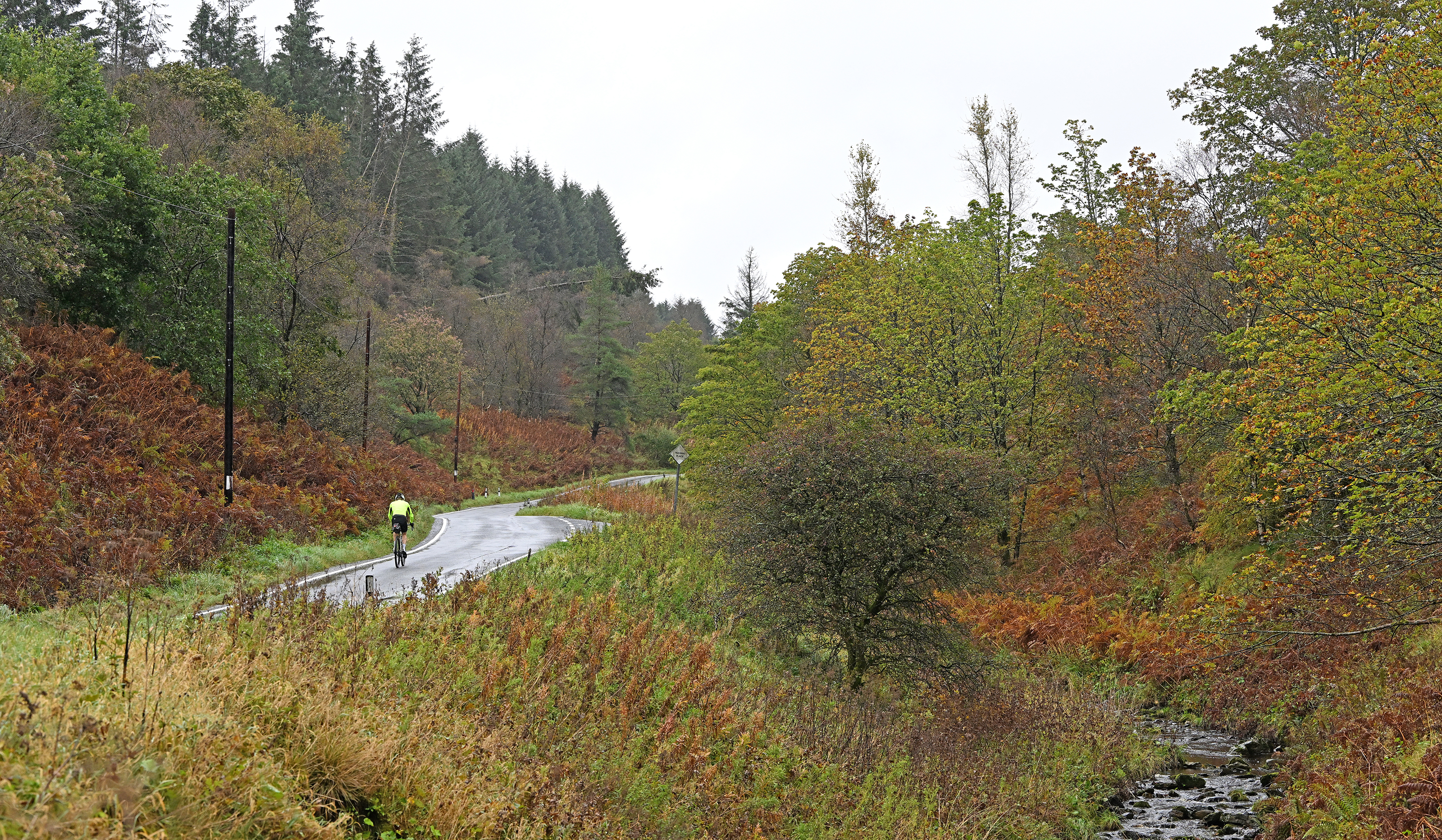
Kirkpatrick C2C ride, day two. Climb between Newcastleton and Hawick
The beauty of the route is that you can create your own itinerary and take as long as you like to complete it. There are several itineraries on the southern Scotland website (see boxout) from two to eight days, the longer one including off route excursions to take in more of the history, sites and tastes (mainly whisky) of nearby towns. When planning an itinerary, bear in mind the surfaces you’ll be taking. Riding a twisty cycle path through woods and over narrow bridges is not fast going, and even doing just 80 miles in a day means I have to push on where I can – partly just to stay warm.
The rain that soaked me at the start of day two continues all the way to our morning stop in Hawick. The beautiful countryside between the two points is largely obscured by cloud. At one point I’m so wet and cold I have to change into dry kit at the side of the road. It would be fairly unenjoyable were it not for the 10 miles of gentle climbing out of Newcastleton that go straight into my top 20 favourite stretches of road. In summer I’d be tempted to turn around and ride it again.
After my second hot drink and slice of cake in Hawick I have to make a decision. The weather is foul and I still have 70 miles to get to the coast. Driving to Galashiels and resume riding there gets the nod. I feel another tinge of guilt, however, upon meeting two riders heading the other way. We stop for a chat as they mend a puncture and lend them a track pump.
They were riding to Stranraer – into that wind – to catch a ferry to Ireland in four days’ time. It is late in the afternoon by now. “Where have you got to get to tonight?” I ask, impressed by the amount of kit they were carrying and slightly worried they’d miss their ferry if this wind kept up. “We’ll just stop wherever,” one of them replies. “We’re sleeping in bivvy bags.” I decide not to tell them about my three-star hotel and efforts to dry my shoes out overnight, wish them luck and carry on.
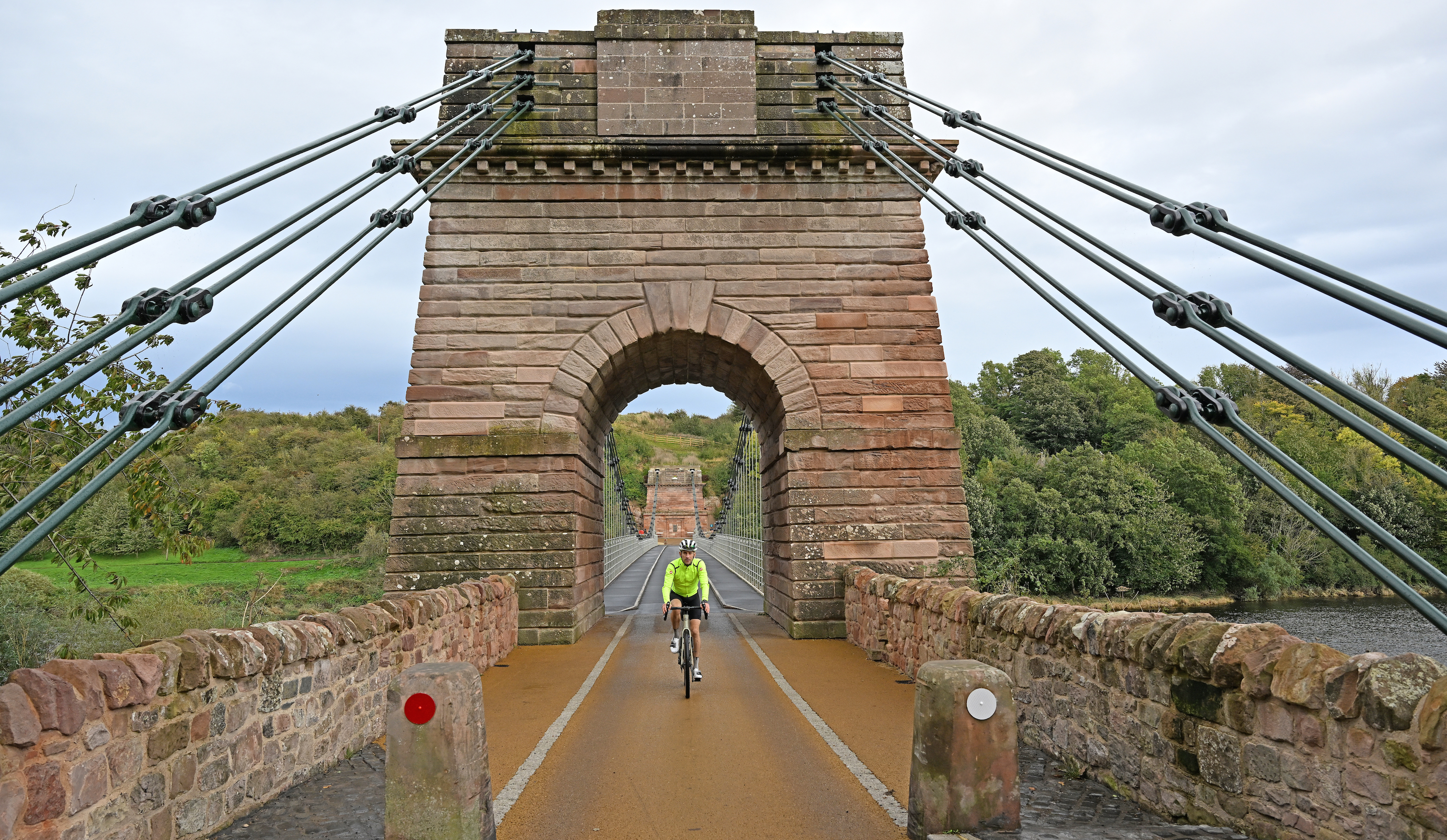
Kirkpatrick C2C ride day 2, Union Bridge over the River Tweed
The last 50 miles into Eymouth is rolling but overall downhill, including a short diversion into England and over the quite stunning Union Bridge that spans the river Tweed. As I ride the final miles, I find myself wondering a) if I could have ridden the whole route in two days and b) whether or not anyone could ride the route in a day.
Unbeknown to me at the time, the FKT (fastest known time) already exists – Josh Wood completed it in 23 hours and eight minutes. That time is far from unbeatable, but it’s impressive considering the terrain and cycling infrastructure that has to be navigated. And while I won’t be returning to try to set a new FKT, the idea of doing this ride with friends over a few days in better weather is very appealing indeed. But there’s no way I’m sleeping in a bivvy bag.
Ride logistics

How to get there
Stranrear is not the easiest place to get to without a car. We got the Glasgow service from London Euston, getting off at Carlisle. From there we drove to Stranrear which is still two-and-a-quarter hours away. There are local train services running from Glasgow, but it is a long journey. It’s easier from Northern Ireland with regular ferry services from Belfast. Eyemouth is nine miles north of Berwick upon Tweed which is on the Edinburgh - London Kings Cross train route, and just off the A1.
Riding the route
The South of Scotland website has several recommended itineraries for those wanting to tackle it in different time frames, along with recommendations for places to stay and points of interest along the way, and gpx files of the route. scotlandstartshere.com/kirkpatrickc2c/
Where to stay
One our first night we stayed at the three star North West Castle Hotel overlooking the bay at Stranraer. Spacious and quiet, it’s also the only hotel where we’ve eaten overlooking a curling rink. Sadly the coffee at breakfast left alot to be desired.
Our halfway point was the three star Eskdale Hotel in Langholm. A small city centre hotel, it was cosy and comfortable with a good restaurant. But still no coffee machine at breakfast.
After reaching Eyemouth we opted to drive down to Berwick-Upon-Tweed ahead of the train journey home early the next morning. We stayed at The King’s Arms Hotel in the town centre which had a very good restaurant and, at last, good coffee
Where to eat
Due to timings, and being out of season we ate at our hotels. On route we stopped at two great little cafes for genuinely excellent mid ride coffees and cake. Cafe Rendevous in Wigtown 30 miles in to day one had a great selection of food while Cafe Damascus Drum in Hawick, 56 miles into day’s two ride was equally as good. There are many other places to stop and eat, but if you’re riding the route out of season, I would recommend checking your planned stops and times you’ll be reaching them, as some might not be open when you arrive.

Editor of Cycling Weekly magazine, Simon has been working at the title since 2001. He first fell in love with cycling in 1989 when watching the Tour de France on Channel 4, started racing in 1995 and in 2000 he spent one season racing in Belgium. During his time at CW (and Cycle Sport magazine) he has written product reviews, fitness features, pro interviews, race coverage and news. He has covered the Tour de France more times than he can remember along with the 2008 and 2012 Olympic Games and many other international and UK domestic races. He became the 134-year-old magazine's 13th editor in 2015 and can still be seen riding bikes around the lanes of Surrey, Sussex and Kent. Albeit a bit slower than before.